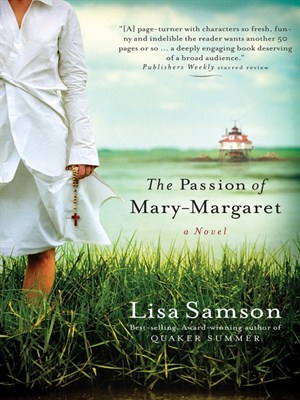 Publishers Weekly review of Lisa Samson’s novel The Passion of Mary-Margaret said, “A talented novelist who isn’t afraid to take risks.” They got that right. At one time, certain topics were “taboo” in Christian fiction. Either that’s changed or Lisa has broken all the taboos. The Passion of Mary-Margaret delves into abuse, prostitution, STIs, out-of-wedlock pregnancies, Catholicism, and drug use, among other things. It’s a book that makes you think and think hard.
Publishers Weekly review of Lisa Samson’s novel The Passion of Mary-Margaret said, “A talented novelist who isn’t afraid to take risks.” They got that right. At one time, certain topics were “taboo” in Christian fiction. Either that’s changed or Lisa has broken all the taboos. The Passion of Mary-Margaret delves into abuse, prostitution, STIs, out-of-wedlock pregnancies, Catholicism, and drug use, among other things. It’s a book that makes you think and think hard.
Mary-Margaret is the only daughter of a woman who, just before she took her final vows as a religious sister, was raped by a seminarian. Because her mother died at her birth and was unable to follow her dream, Mary-Margaret’s only desire is to become a religious sister. She’s raised by religious sisters on Locust Island, studies at the convent school and, like her mother, is about to take her final vows when Jesus makes a strange request of her.
Jude Keller is Mary-Margaret’s childhood friend—a handsome, troubled boy who runs away from the island and searches for fulfillment in drugs and sex. He keeps coming back to Mary-Margaret and the attraction they feel for each other—one so dirty, the other so pure. Their lives revolved around the lighthouse; a beautiful, attractive thing to Mary-Margaret, a dark, terrifying thing to Jude.
Slowly, as Mary-Margaret writes down her memories of her past and works through the events of the present, the story unravels. Just when you’re about to find something out, Mary-Margaret’s reminiscing gets interrupted—or she moves from the present back to the past. Yet in this circular fashion, everything is revealed at just the right time. Nothing is as it seems on the surface in the novel, and the ending was both surprising and delighting.
I love Mary-Margaret’s conversations with Jesus, the way He pops up unexpectedly and is so human and yet also so divine and mysterious. He demonstrated how God knows everything and works in our lives for our good, yet He only tells us what we need to know when we need to know it. Mary-Margaret’s trust was inspiring, yet at the same time, she faced doubts too, like anyone else.
The only thing I found unnecessary in the book was the epilogue, written by one of Mary-Margaret’s friends. To me, it detracted from the power of Mary-Margaret’s words and added nothing to the story that we didn’t really already know.
The Passion of Mary-Margaret makes me want to write, to put words together with the beauty that Lisa does, to touch readers the way this book has and will. And I find hope in the way that Lisa has grown and learned as a writer. When I first heard that she was to be the keynote speaker at Spring WorDshop, I went looking for one of her books in our local library. They just happened to have the very first book that she ever wrote.
When I told Lisa that I read her first book, she was embarrassed. She admitted it’s not a great book. (I can only be grateful that my first efforts at being an author aren’t published as hers are!) At the same time, I find it a great encouragement to have read her first book and her latest book. To see that it does take time and effort to become a great writer. Sure, there are a few one-book wonder authors (like Margaret Mitchell, Harper Lee, Emily Bronte), but most of writers gain skill and ability as they keep writing, as Lisa Samson clearly has.

No Responses Yet